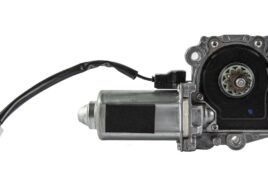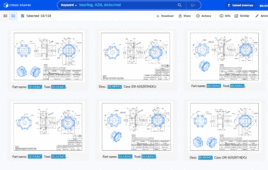Polymer-based solutions for fire protection and buoyancy help progressive riser technology push the limits.
Contributed by Collin Gaskill, Product Development Engineer & Patrick Waal, Head of Sales, Trelleborg Offshore

Buoyancy units can be fitted along the length of the riser to reduce the weight of riser joints in water.
The oil and gas industry is renowned for continuously pushing the limits. The exploration of offshore oil and gas continues to move into deeper waters and the demands for drilling operations to perform faster and more effectively to provide higher cost savings and safe well completions have grown. Adding to this challenge is the requirement to extract more oil and gas than ever before, and exploit even harsher reservoir environments in new locations around the world. With these challenges in mind, we look at why next-generation corrosion-free, polymer-based solutions can be the vital element to ensuring the protection of people, structures and equipment on offshore risers from surface
to seafloor.
Exceeding expectations
Although technology has advanced to better address the ever-changing needs of the offshore environment, customers still require superior, cost-effective solutions with an increased focus on onboard safety and extended service life; increasing to up to 40 years from 20 years.
For both of these focus areas, choosing the most appropriate material is imperative and not surprisingly, polymer materials are becoming a more popular choice within the offshore industry. Polymer-based materials such as rubber and polyurethane are naturally flexible and very durable. Compared to alternative materials, such as steel, ceramic wool or fiberglass, polymer-based materials can withstand greater temperature extremes, weather conditions, and vessel movements while offering an exceptionally high durability. It is a diverse group of materials that can perform at every level to damp, seal and protect, and most of all has an extremely long lifespan.
Safety for challenging environments

Trelleborg’s rubber-based fire deluge system, called Elastopipe, under testing
It is no surprise that onboard safety is a key priority for offshore riser platforms but this is becoming progressively difficult in increasingly challenging environments as installations move further offshore.
Advanced fire protection systems are critical to ensuring onboard safety, whether it is the platform’s surface protection, an onboard deluge system or coating for the pipes and flanges for example. The performance of these systems is essential for the safety of personnel, asset protection and preventing fire escalation.
So, in the offshore oil and gas sector where the risk of uncontrolled, rapid fire spread is greater than most, firestop solutions need to provide full assurance to the onboard team that they will not fail to protect against fire. If damage is caused, costly shutdowns and repairs would be required and in the worst-case scenario, the platform may fail altogether.
The harsh offshore weather environment causes metal products and components to be susceptible to rust and corrosion, which is detrimental to the performance and function of the platform. Additionally, ceramic wool and similar materials used for fire protection will become less effective when wet. These less than optimal solutions simply are not an option when protecting people, structures, and equipment.
Passive fire protection

Installation of Elastopipe fire deluge system
Passive fire protection solutions are available in a series of materials and products to protect personnel, equipment, critical components and structures, and to assist emergency response activity by buying time to gain control of the fire, and evacuate the area. With proven engineering and manufacturing techniques for protection of all kind of fires, from cellulose to hydrocarbon and jet fire, rubber materials—which are built-up with layers that meet corrosion, thermal, fire, and mechanical protection requirements—protect structures from exceeding temperature limits. Rubber has the unique capability of withstanding weather conditions and vessel movements, providing ease of inspection and fire protection over the life of a project, which could extend over 40 years.
Throughout the fire exposure period, it is key that any fire protection specified for use on an offshore facility provides the required fire protection and integrity; protecting areas between modules and decks to prevent the spread of flames and hot fumes. The critical temperature on the surface of a component is project specific information, with typical values of 392° to 752°F. Similarly, in accordance with the Health and Safety Executive (HSE), the generation of smoke and non-toxic fumes must remain low. Additionally, the dampening, noise reducing, flexible nature of rubber-based materials protects equipment from vibration, collisions, explosions and earthquakes.
Topside applications

Trelleborg’s Vikodeck offers surface protection against blast, jet and pool fire in harsh offshore oil and gas environments.
Laydown decks—The platform laydown deck areas are susceptible to regular impact and abrasion due to containers being loaded onto the platform, as well as to the harsh offshore elements. Before fire protection is considered, the deck should be protected against chemical and mechanical conditions and ensure that it is resistant to fatigue. A flexible decking material capable of withstanding these conditions is an ideal solution. Rubber provides the corrosion protection in addition to environmental and impact protection, while maintaining the required fire protection rating.
Surface tiling should feature insulation to isolate fire temperatures from areas below and should also ensure a non-slip surface for worker safety. The flexibility of a rubber-based tile means that it can take up movement in any direction, reducing the likelihood of cracking. Similarly, as tiles are regularly exposed to the sun, it ensures UV and ozone protection, so that surface is not damaged over time.
Flanges—Considered as one of the weakest areas of any platform or refinery, fire protection for nuts and bolts used in flanges should be considered. Typical fire protection covers the complete flange with a housing, not allowing for easy inspection of the units. By using a molded rubber-based material on just the flange nuts, the stud bolts are protected from elongating and the flange from breaking the seal during a fire. Installation is simplified with lowering installation times, regular inspection is facilitated and overall weight is lowered.

Trelleborg Firenuts —
nut and bolt fire protection
Fire deluge systems—With a large number of aging platforms and rigs currently in operation and the threat of critical failure looming, the onboard deluge system is one application in particular where benefits from flexible fire protection will help reduce fire risks and potential downtime or closure.
By choosing a flexible, rubber-based material, these deluge systems are non-corroding and can withstand jet fires with a heat flux of 390kW/m² at temperatures above 2552°F.
Extending service life though corrosion protection
One of the most effective methods of extending the service life of a riser is to protect it from corrosion, particularly in the highly corrosive splash zone region. The splash zone is the area immediately above and below the water’s surface and is a major corrosion concern for offshore installations. As the water level rises and falls the metal surfaces of the riser are alternately becoming wet and dry, which causes the metal to corrode when the saline water is exposed to oxygen.
External surfaces exposed in the splash zone should be protected with special corrosion protection systems. Rubber-based coating on risers as a form of corrosion protection is an extremely popular solution and is widely recognized in the offshore industry as the most effective method of riser corrosion protection particularly in the highly corrosive splash zone region.

Rubber-based coating on a riser in the highly corrosive splash zone
When selecting a corrosion coating for a riser, manufacturers should ensure that the supplier they select can fully customize the coating material to meet the specific project needs. Most rubber-based solutions can incorporate a range of protective qualities such as anti-fouling to inhibit marine growth. Additionally, rubber-based corrosion protection solutions are resistant to abrasion, chemicals, wear, blast, impact, jet fire, ozone, UV, and salt water.
An important feature of any riser corrosion coating is the fact that the coating is chemically bonded to the metal surface or substrate permanently and will not crack or disbond. As a material specifically engineered to protect against sea and weather conditions, rubber corrosion coatings will guard against corrosion for the lifetime of the riser.
In addition to the splash zone, rubber-based riser corrosion protection can be applied as a rubber lining for any exposed steel components located on a riser.
Riser protection surface to seafloor

Distributed Buoyancy Modules are used to reduce the top tension loads by providing uplift to sections of the riser.
The drill riser provides a conduit for the drill string and drilling fluids from the ocean floor to the rig. A drilling riser typically has a large diameter, low-pressure main tube with external auxiliary lines that include high-pressure choke and kill lines for circulating fluid. All of these lines need to be protected during handling, storage, deployment, retrieval, and drilling operations.
Some of the most trusted protection systems for bare riser joints include polymer-based protection covers. These protection covers are manufactured from polyurethane or polypropylene and are specifically designed to protect the drilling riser from impact damage when running or retrieving through the drill floor and moon pool area or during handling operations in the riser storage bay.
Drilling risers—which can reach lengths of 10,000 ft or more and weigh millions of pounds—must be kept in tension to ensure safe operation of the equipment. By decreasing the requirement on vessel tensioning systems to a more manageable level, discrete buoyancy units can be fitted along the length of the riser to reduce the weight of riser joints in water. These buoyancy units are made out of a polymer-based foam that not only lowers the weight of the riser string to a manageable amount but also protects the riser and auxiliary lines from impact and abrasion subsea.
Taking protection to the next level, a newly designed and tested helically grooved buoyancy option is available on the market that not only optimizes uplift, but also effectively eliminates riser motions and higher levels of drag in onerous offshore current environments compared to traditional riser buoyancy. The new multi-functional solution integrates the technology to suppress vortex-induced vibrations (VIV) and reduce drag into riser buoyancy equipment during manufacturing, essentially eliminating the requirement of ancillary suppression equipment, alleviating complicated and time intensive riser running and retrieval procedures.
Similarly, buoyancy technology is used to offset tension loads on deep-water umbilicals and risers for floating production systems. Distributed Buoyancy Modules are used to reduce the top tension loads by providing uplift to sections of the riser to generate pre-defined configurations that allow the vessel a full range of surface movement without putting undue stress on subsea lines. These configurations include “Lazy Wave,” “Steep Wave,” “Lazy-S,” “Steep-S,” and “Pliant Wave.”
Evolving riser technology for the future

Trelleborg’s newly designed and tested helically-grooved buoyancy options not only optimize uplift, but effectively eliminate riser motions.
As complicated exploration and production activities target more challenging reservoirs, an evolution of current riser technology will be required to ensure continued safe and cost-effective operations. Advanced engineering analysis and simulation design tools provide the ability to effectively develop new riser equipment technologies considering the real world environmental and operational challenges they will be required to perform under.
Computational Fluid Dynamics (CFD) analysis studies provide the means for exploring optimized equipment designs with consideration of minimizing hydrodynamic loading. Riser technology can be successfully designed to be multifunctional, suppressing VIV and reducing drag simultaneously while performing its primary protection and buoyancy roles. Local and global Finite Element Analysis (FEA) allows for equipment to be designed smarter, minimizing required size and material while optimizing loading paths, performance and design lives. Employing these advanced engineering tools will help advance riser technology moving into the future to expand and extend the capabilities of the industry.
Conclusion
While deep-water drilling and production has been revolutionized by increasingly advanced technology in recent years, making high performance and dependable solutions has never been more important. This is because the requirement for equipment to operate safely and effectively while providing peace of mind is becoming more challenging in these demanding and dangerous environments.
By installing effective and reliable polymer riser protection systems, the safety of hydrocarbons transportation installations will be increased. In the harsh offshore oil and gas industry, operators need the assurance of a material that delivers proven performance, without fail. It is the responsibility of the manufacturer to ensure that they can provide high performance and reliable solutions, now more than ever. Similarly, operators should look to work with manufacturers who can provide the most advanced solutions to guarantee performance and importantly, safety. DW
Trelleborg Offshore
trelleborg.com/en/offshore
You may also like:
Filed Under: Materials • advanced, MORE INDUSTRIES








